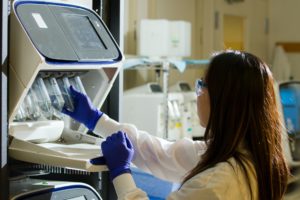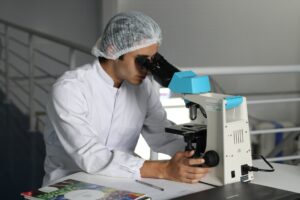Gene Therapy: A Change of Heart
Author: Christina M.H. PowellMany diseases are not a result of an attack from an infectious agent or a loss of function from an injury or environmental hazard, but a problem within the genetic code of a patient. Instead of drugs or surgery to treat symptoms, what if doctors could go directly to the heart of the matter and change the defective or missing genes responsible for serious diseases?

Gene therapy can treat conditions such as a compromised immune system,1 cancer,2 certain forms of inherited congenital vision loss,3 and even heart failure.4,5
The first gene therapy patient was a 4-year-old girl with a genetic disease that left her defenseless against infections. The treatment was temporarily successful. Children with her condition die in infancy or early childhood unless treated with either a bone marrow replacement therapy or ongoing injections of enzyme replacement therapy. Bone marrow replacement therapy works best when the patient has a matched sibling donor. Otherwise, the patient faces many potential complications. Enzyme replacement therapy is expensive, and patients need injections once or twice a week. Gene therapy offers the promise of a normal life.
Any pastor who has visited a sick child in the hospital can understand the value of such a treatment. However, pastors may wonder if altering the genetic code is an example of scientists and doctors “playing God.” Somewhere between embracing all technological advances as blessings and fearing science run amok lies a balanced understanding of the value and dangers of gene therapy.
DESIGNING PAST DANGERS
Gene therapy delivers a treatment directly where the body needs it, precisely supplying a healthy copy of a defective or missing gene. Ideally, it delivers the gene safely to the right cells in the body, expressed at the right level to cure the disease without causing toxic side effects or an unwanted immune response.
In many cases, viruses serve as vectors to carry the desired gene into cells. This requires removing the genes needed for a viral infection and replacing them with the therapeutic genes. However, sometimes the human body can react to these viral vectors as if they were disease-causing intruders, mounting an immune response that can lead to inflammation and even organ failure.
An example of this danger is the death of Jesse Gelsinger, an 18-year-old boy who died in 1999 in a clinical trial for gene therapy four days after receiving an injection of a viral vector containing a therapeutic gene. His body mounted a massive immune response to the viral vector, resulting in brain death and the failure of multiple organs. His death sparked widespread concern about the potential dangers of gene therapy and slowed progress in the field for many years.
A second danger is that the virus may infect and damage healthy cells, rather than impacting only the targeted cells. Also, a few copies of the viral vector used to deliver the therapeutic gene could insert into unintended places in a patient’s DNA, disrupting normal genes. This genetic damage can result in leukemia or other cancers. Finally, although the viral vectors are missing the viral genes needed to cause infection, once inside the human body, there is a small possibility that the virus could recover its original ability to cause disease.
Thus, scientists and doctors must exercise great caution when designing the method for delivering the therapeutic gene to the right cells in the patient’s body. The potential risks of gene therapy suggest that the approach be reserved for serious diseases where the benefits of the treatment offset the potential dangers.

CONSIDERING APPROPRIATE LIMITS
Altering the genetic blueprint of a human being feels like “playing God” on a whole level beyond prescribing a course of penicillin to treat an infectious disease. However, a treatment that inserts a working gene for a certain enzyme into somatic (body) cells within the patient poses fewer ethical challenges than gene therapy that alters germ line cells, allowing the new gene to be passed on to future generations.
Gene therapy that affects body cells poses risks only to the patient. However, gene therapy that alters germ line cells poses unknown risks to individuals not yet born. In addition, corrections within a specific tissue of one person do not change the future gene pool for human beings, while germ line alterations would. Of course, germ line gene therapy holds the power to eradicate a genetic disease for a person’s children and grandchildren. However, germ line gene therapy could have unknown effects on the development of a child or unexpected side effects. An individual not yet born would be subject to potential dangers without ever having a choice in whether to undergo the treatment. For this reason, the United States federal government forbids the use of research funds for human germ line gene therapy.
The same gene therapy techniques that cure disease theoretically could bring about human enhancement. Should gene therapy be limited to correcting genetic diseases, or is it appropriate to enhance traits such as those that lead to greater athletic ability or intelligence? When is gene therapy appropriate, and where should doctors draw the line between traits considered normal and those viewed as a disability?
How would the existence of gene therapy for certain traits or conditions change the way we viewed people with those traits or conditions who chose not to undergo gene therapy? For example, some parents of children with Down syndrome would not be interested in a gene therapy that might change certain positive characteristics of their children in the process of genetically reversing Down syndrome.
As gene therapy becomes safer and easier, society will need to consider the appropriate limits for genetic alterations. The technique can make a diseased heart return to health after a brief treatment, a scientific breakthrough with the potential to bless many people. As God asked Job so long ago, “Who has put wisdom in the mind? Or who has given understanding to the heart?” (Job 38:36, NKJV).6
Christians can view scientific knowledge ultimately as a gift from God, while appreciating the need for limits in the exercise of our human creativity in the laboratory. We cannot truly play God, but we can partner with Him in finding new ways to bring healing to people.
NOTES
1. F. Ferrua, I. Brigida, and A. Aiuti, “Update on Gene Therapy for Adenosine Deaminase-deficient Severe Combined Immunodeficiency,” Current Opinion in Allergy and Clinical Immunology 10, no. 6 (2010): 551–556.
2. A. Coghlan, “Gene Therapy Cures Leukemia in Eight Days,” The New Scientist (26 March 2013) (accessed November 22, 2013).
3. J.W. Bainbridge, A.J. Smith, S.S. Barker, et al., “Effect of Gene Therapy on Visual Function in Leber’s Congenital Amaurosis,” New England Journal of Medicine 358, no. 21 (May 2008): 2,231–2,239.
4. L. Tileman, A. Lee, K. Ishikawa, et al., “SUMO-1 Gene Transfer Improves Cardiac Function in a Large-Animal Model of Heart Failure,” Science Translational Medicine 211, no. 5 (13 November 2013): 159.
5. Mount Sinai Medical Center, “Long-lasting Gene Therapy Benefits Advanced Heart Failure Patients,” ScienceDaily (19 November 2013): http://www.sciencedaily.com/releases/2013/11/131119100927.htm (accessed November 22, 2013).
6. Scripture quotations marked NKJV are taken from The New King James Version / Thomas Nelson Publishers, Nashville: Thomas Nelson Publishers., Copyright © 1982. Used by permission. All rights reserved.
